The Germans loved their leader so much that the Nazis did not even have to deal with the rigging of the elections. The opponents of the dictatorship were stuck in a dull apathy. And the hard opposition can hardly even be called a couch.
Paradoxically, the ancestors of modern German historical politics (or rather propaganda) were the Soviets, who from 1945 tried to prove that all possible "anti-fascists" had gathered in the German Democratic Republic. Of course, unlike the Federal Republic of Germany consisting only of "Hitler's brown tombs" .
In allied with the Americans, the English and the French (until recently their mortal enemies!), West Germany also began to frantically create a new national identity, cut off from Nazism - the ideological basis of the post-war state.
One of the most important ways of reducing the cognitive dissonance associated with the war and accelerating the process of transforming the consciousness of the "nation of executioners" into a "nation of victims" was to create new heroes:members of the German resistance movement . Although it was a creatio ex nihilo, task it really produced amazing results.
Falsify the election results? What for?
92%, 95%, 95%, 95%, 88% - these were the results (with the turnout around 95%) obtained by Adolf Hitler and the NSDAP in the elections and plebiscites organized in 1933 and 1934. Although they took place in an atmosphere of intimidation of political opponents, the excellent biographer of Hitler, Ian Kershaw, admits that the Nazis did not have to manipulate their results. The Führer really did enjoy the support of the lion's share of German society.
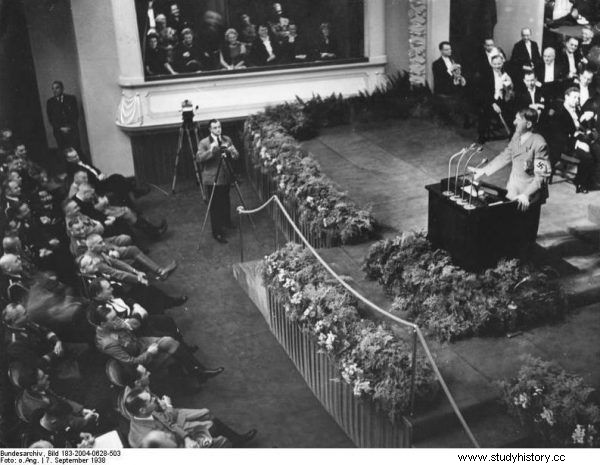
Hitler enjoyed enormous support from the public, as evidenced by the attendance at his speeches. Photo from the Nuremberg Parteitag in 1938.
Not only that, Joseph Goebbels himself admitted in his memoirs that the latest result (88% support for the question of combining the positions of president and chancellor of the Reich in the person of Adolf Hitler) was deeply disappointed. This is another clue that the official results quite accurately reflected German reality. Subsequent elections and referenda approving the re-militarization of the Rhineland (1936) and the Anschluss of Austria (1938) already resulted in support of around 99 percent.
The crowd is collapsing? Let's join the NSDAP!
One could, of course, argue that the German support for Hitler was not then tantamount to approving the start of hostilities and the extermination of the Jews. However, this view is worth confronting with the analysis of the number of NSDAP members:1 million in 1934, 3 million in 1936, 5 million before the outbreak of the war and an amazing 8 million in 1945. The Adolf Hitler regime received the greatest support after six years of bloody, devastating war!
The eight million members of the NSDAP are not the entire nation yet, but how did the rest of the Germans behave a few months before the inevitable defeat? Richard J. Evans in the book War of the Third Reich Notes: “Open opposition to Nazism was still rare. Blunt apathy was much more common. ”

The question asked by British historian Ian Kershaw is justified here:instead of wondering why the Germans lost the war, let's try to explain why they did not fail until 1945. Moreover, why did they stick to the madman until the very end, without creating a real, organized resistance:neither political nor military?
Couch, chatty opposition
Hitler's political opponents, with the maximum dose of good will, include literally a few - microscopic in the scale of society - organizations. When in 1942 the spy network subordinated to the intelligence of the USSR, known as the Red Orchestra, was liquidated, the Gestapo tried to arrest everyone who had any, even minimal contact with the conspirators. Effect? 120 arrests and 50 death sentences.
The core of the White Rose (a Christian-oriented anti-Nazi group operating mainly in Munich), of which Germany is so proud today, was made up of only five people, and we can add a dozen looser collaborators. The effects of Sophie Scholl and her friends were somewhat miserable - some anti-Nazi graffiti and six leaflet designs copied from several hundred to several thousand copies.
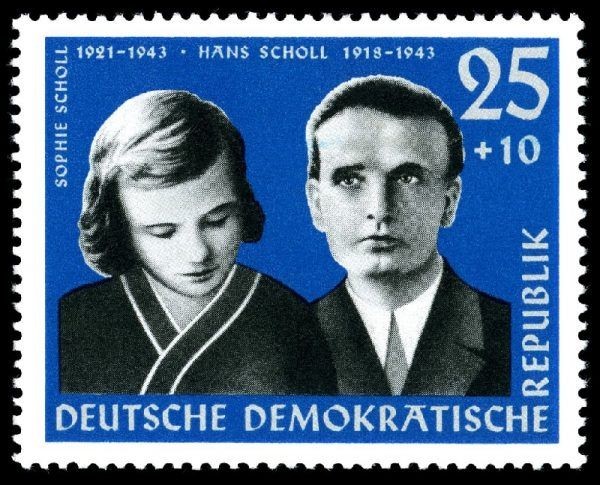
The effects of the activities of the White Rose anti-Nazi group were somewhat meager. East German stamp from 1961 showing Sophie Scholl with her brother.
And it is not about ridiculing the undoubted courage and heroism of the members of Weiße Rose , but to realize the numerical proportion of the members of this organization to (for example) the number of people involved in the functioning of the Polish underground state. The question of whether the White Rose is better recognized in the world today or the Home Army is obviously the rhetorical one.
The so-called The Kreisau Circle, a loose group of about 100 intellectuals, who met only three times in a larger group to talk about the future, anti-Nazi Germans. Interestingly, in May 1944, the conspirators wanted to start peace negotiations with the Allies, taking as their basis the borders of the Reich from 1914!
In 1989, Krzyżowa was recognized as a symbolic place for Polish-German reconciliation. It was there that Chancellor Helmut Kohl, referring to the heritage of these one hundred people, and Polish Prime Minister Tadeusz Mazowiecki, who had a mandate of ten million members of Solidarity behind him met ...
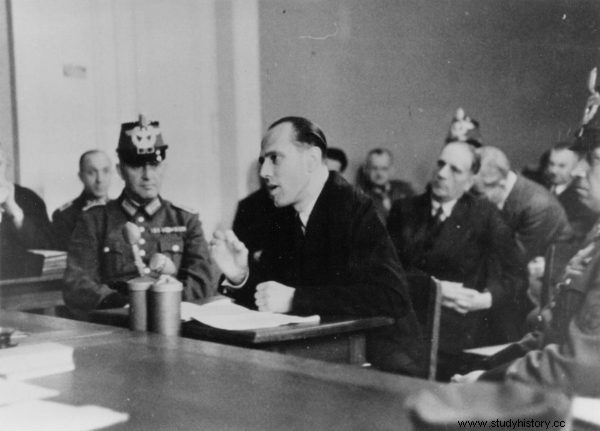
The famous Kreisau Circle gathered only three times. The photo shows one of its founders, Helmuth von Moltke, in court in January 1945.
Farce instead of assassination
As Richard J. Evans rightly points out in his book War of the Third Reich :
Neither of these organizations had a chance to overthrow the Nazi regime. Only one group could do this, namely the military opposition .
The problem is that the conspirators in the Wehrmacht were also few, unimaginably inept and, most shockingly, extremely cynical. Claus von Stauffenberg, the most famous opponent of Adolf Hitler in the world today, converted to anti-Nazism only after the defeat of the Wehrmacht. Previously, he eagerly supported the Führer's policy, and in 1939 he wrote about Poles as follows:
The local population is an incredible mob, a lot of Jews and a lot of mixed people. A nation that certainly feels good only under the knout. Thousands of prisoners of war will do our agriculture very well. In Germany they will certainly be very useful, hardworking, willing and undemanding .
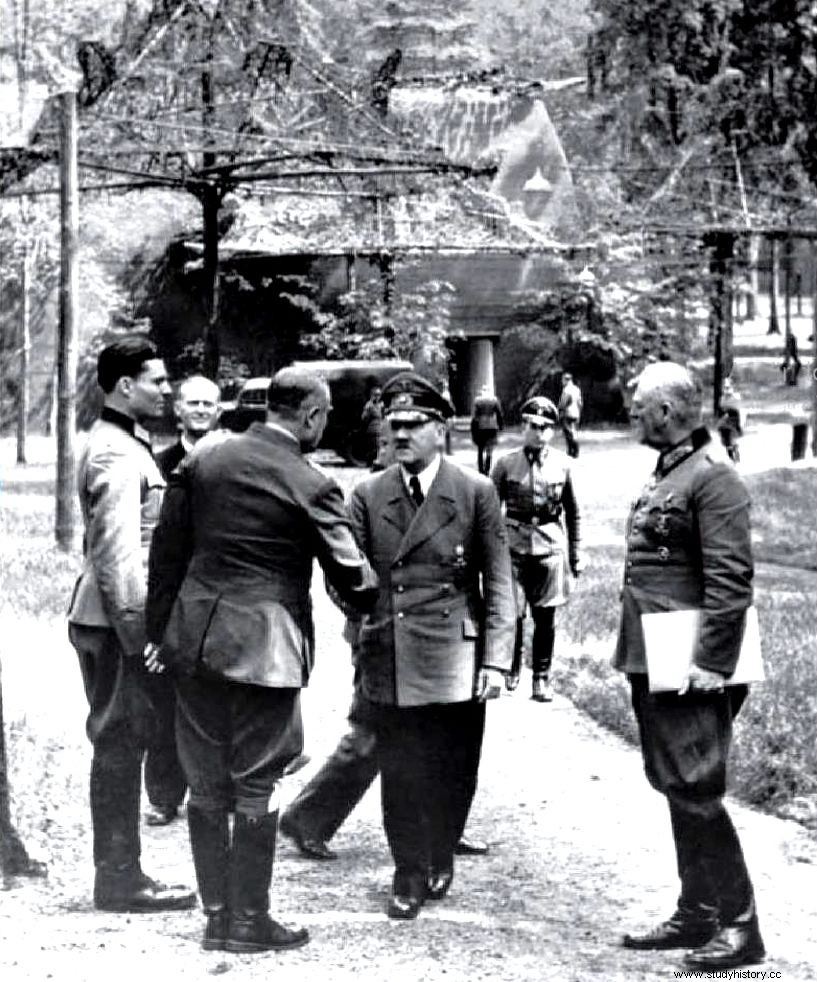
The famous Claus von Stauffenberg converted to anti-Nazism only in the face of the defeat of the Third Reich. The photo was taken in front of Hitler's headquarters in the Wolf's Lair a few days before the attack. Stauffenberg is standing first from the left.
It is worth recalling here that the first attempted assassination attempt by Stauffenberg did not take place at all - the attack was called off at the last minute due to the indecision of the leaders of the plot in Berlin (it was about the absence of Himmler, whose principals wanted to liquidate the assassin together with Hitler). The staff meeting that day took place in a bunker, not in a wooden barrack. Overall:in all likelihood the coup had a chance of succeeding that day.
Furious, Stauffenberg decided not to look at anyone anymore, but the next time he tried, his nerves failed! He failed to arm the second load, although it was enough to leave it in the briefcase. Then the multiplied force of the blast would also kill Hitler. When the Wolf's Lair bomber flew to Berlin, it turned out that Operation Valkyrie (which was supposed to allow the conspirators to seize power) also ended in failure due to a delay of several hours caused by another nightmarish indecision of the conspirators.

Hamletizing Generals
It is hardly surprising that this festival of awkwardness, observing the behavior of those on whom the conspirators counted the most, i.e. generals such as Rommel, Kluge or Fromm. By favoring the attackers, they tried to "be" and "not" in the conspiracy at the same time. Thus, by not directly engaging, they drastically reduced the chances of a coup d'état success, and in the end they paid for the defeat with their heads anyway!
Such behavior is difficult to understand, especially in experienced military, who should know that treason cannot be partially involved ... , in short:all people who might have known about the preparations for the attack, but did not inform the authorities about it).
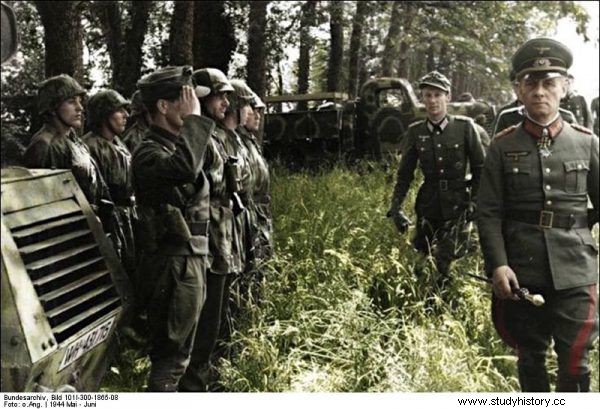
Even the famous "Desert Fox" Erwin Rommel tried to be among the conspirators and not be at the same time. One of the last photos of the field marshal during the review of the 21st Armored Division in France.
The result was 5,000 arrests. At that time, the Wehrmacht numbered 11 million people, which means that less than one in two thousand soldiers was involved in the conspiracy ... "Despite von Stauffenberg's attempts to gain wider support (...) the military-conservative opposition had very few supporters in German society ”- we read in the book War of the Third Reich Richard J. Evans .
Don't count on the Germans. Do it yourself
The best, symbolic summary of the meagerness of the German resistance movement is the story of the most spectacular attack on Hitler on November 8, 1939. After the explosion in the Bürgerbräukeller beer hall, which cost the lives of eight people (but not Hitler, who left the room earlier), the raging Gestapo arrested over 1,000 people suspected of participating in the attack within a few hours. By complete coincidence, it was found a moment later that the attack was made by a modest carpenter, Georg Elser. Alone. One.
Get the Evans trilogy at a discount on Empik.com:

